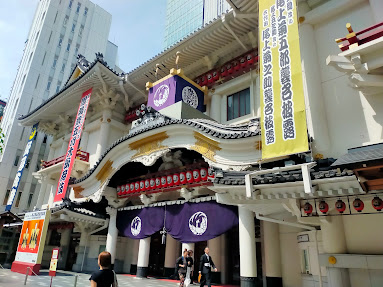With its traditional Japanese façade and modern interior, Kabuki-za is the heart of kabuki theater — the place where Japan’s most famous kabuki actors perform, and where fans from around the world gather.
If you’ve ever thought, “I want to see kabuki while I’m in Japan,” this is the perfect place to start.
And don’t worry — even if you don’t speak Japanese or know anything about the storylines, you’re not alone. This guide will help you enjoy kabuki like a pro, even on your first visit.
What Is Kabuki?
Kabuki is a traditional Japanese form of theater known for:
-
All-male casts (even the female roles are played by men),
-
Bold costumes and striking makeup,
-
Stylized acting and movement,
-
Epic stories full of love, revenge, loyalty, and drama.
Though the language used is often classical Japanese, the performances are highly visual and emotional — so even without understanding every word, you can feel what’s happening.
Do I Need to Understand Japanese?
Not at all.
Even most Japanese people don’t fully understand classical kabuki dialogue!
But you don’t have to miss out — the theater provides:
Earphone Guides with real-time English explanations,
English programs and sometimes subtitles,
Clear story summaries available online or in pamphlets.
So relax — just enjoy the show!
Isn’t Kabuki Really Long?
Yes — some kabuki plays are very long.
For example, the full version of the famous Kanadehon Chūshingura (The Treasury of Loyal Retainers) runs over 10 hours!
That’s why modern kabuki performances usually feature selected scenes instead of the entire play.
It’s similar to Wagner’s operas — they’re legendary, but too long for one sitting, so they’re often performed in parts or highlights.
Think of it like watching the “best scenes” of a historical drama — exciting sword fights, emotional farewells, or dramatic confrontations.
What’s a Kabuki Show Like?
Kabuki-za usually splits its shows into two or three parts each day:
-
Morning, afternoon, or evening sessions
-
Each session features 1 to 3 acts, with intermissions (called makuai)
-
Total run time (with breaks): 2.5 to 4 hours
You can attend just one part — you don’t need to sit through the whole day.
Want a Quick Taste? Try One-Act Tickets
If you don’t have hours to spare, try the Hitomakumi (“Single-Act Tickets”):
-
Buy them on the same day from a special ticket booth
-
First-come, first-served
-
Affordable: around ¥1,000–¥2,000 per act
-
Perfect for beginners or travelers on tight schedules
How to Buy Tickets
You have a few options:
1. Regular Reserved Tickets
-
Purchase online via the official Kabuki-za website or ticketing platforms (some offer English).
-
Choose your seat and date in advance.
-
Prices range from ¥4,000 to ¥20,000 depending on the seat.
2. One-Act Tickets (Hitomakumi)
-
Buy at the same-day ticket window near the theater’s right-side entrance.
-
Check the schedule in advance on the Kabuki-za website.
-
Get there early — tickets are limited and can sell out fast!
3. Tourist Services
-
Some hotels or concierge desks offer help with booking.
-
Tourist information centers may assist as well.
Whether you're a theater lover or just curious about Japanese culture, Kabuki at Kabuki-za is a must-see experience.
Sit back, rent an earphone guide, and let the world of samurai, spirits, and star-crossed lovers unfold before you.
Enjoy the show


Comments
Post a Comment